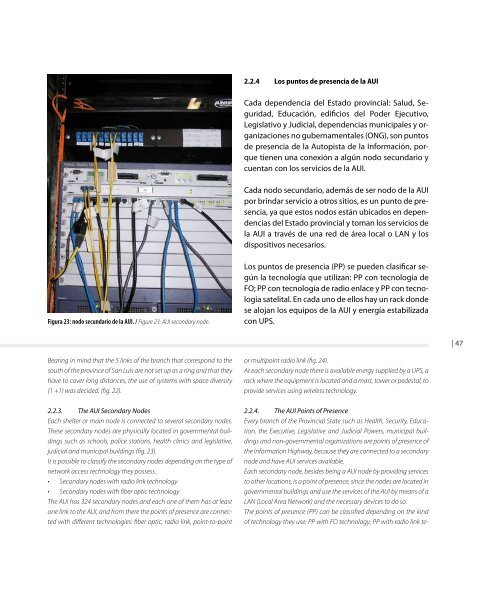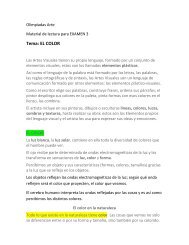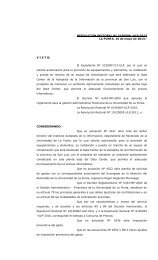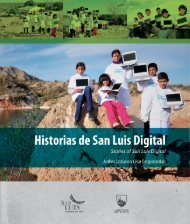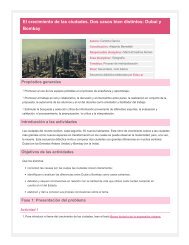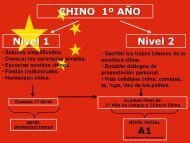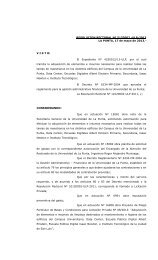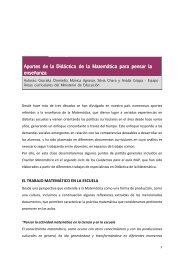e-Book PDF - Universidad de La Punta (ULP)
e-Book PDF - Universidad de La Punta (ULP)
e-Book PDF - Universidad de La Punta (ULP)
Create successful ePaper yourself
Turn your PDF publications into a flip-book with our unique Google optimized e-Paper software.
2.2.4 Los puntos <strong>de</strong> presencia <strong>de</strong> la AUI<br />
Cada <strong>de</strong>pen<strong>de</strong>ncia <strong>de</strong>l Estado provincial: Salud, Seguridad,<br />
Educación, edificios <strong>de</strong>l Po<strong>de</strong>r Ejecutivo,<br />
Legislativo y Judicial, <strong>de</strong>pen<strong>de</strong>ncias municipales y organizaciones<br />
no gubernamentales (ONG), son puntos<br />
<strong>de</strong> presencia <strong>de</strong> la Autopista <strong>de</strong> la Información, porque<br />
tienen una conexión a algún nodo secundario y<br />
cuentan con los servicios <strong>de</strong> la AUI.<br />
Cada nodo secundario, a<strong>de</strong>más <strong>de</strong> ser nodo <strong>de</strong> la AUI<br />
por brindar servicio a otros sitios, es un punto <strong>de</strong> presencia,<br />
ya que estos nodos están ubicados en <strong>de</strong>pen<strong>de</strong>ncias<br />
<strong>de</strong>l Estado provincial y toman los servicios <strong>de</strong><br />
la AUI a través <strong>de</strong> una red <strong>de</strong> área local o LAN y los<br />
dispositivos necesarios.<br />
Figura 23: nodo secundario <strong>de</strong> la AUI. / Figure 23: AUI secondary no<strong>de</strong>.<br />
Los puntos <strong>de</strong> presencia (PP) se pue<strong>de</strong>n clasificar según<br />
la tecnología que utilizan: PP con tecnología <strong>de</strong><br />
FO; PP con tecnología <strong>de</strong> radio enlace y PP con tecnología<br />
satelital. En cada uno <strong>de</strong> ellos hay un rack don<strong>de</strong><br />
se alojan los equipos <strong>de</strong> la AUI y energía estabilizada<br />
con UPS.<br />
| 47<br />
Bearing in mind that the 5 links of the branch that correspond to the<br />
south of the province of San Luis are not set up as a ring and that they<br />
have to cover long distances, the use of systems with space diversity<br />
(1 +1) was <strong>de</strong>ci<strong>de</strong>d. (fig. 22).<br />
2.2.3. The AUI Secondary No<strong>de</strong>s<br />
Each shelter or main no<strong>de</strong> is connected to several secondary no<strong>de</strong>s.<br />
These secondary no<strong>de</strong>s are physically located in governmental buildings<br />
such as schools, police stations, health clinics and legislative,<br />
judicial and municipal buildings (fig. 23).<br />
It is possible to classify the secondary no<strong>de</strong>s <strong>de</strong>pending on the type of<br />
network access technology they possess.<br />
• Secondary no<strong>de</strong>s with radio link technology<br />
• Secondary no<strong>de</strong>s with fiber optic technology<br />
The AUI has 324 secondary no<strong>de</strong>s and each one of them has at least<br />
one link to the AUI, and from there the points of presence are connected<br />
with different technologies: fiber optic, radio link, point-to-point<br />
or multipoint radio link (fig. 24).<br />
At each secondary no<strong>de</strong> there is available energy supplied by a UPS, a<br />
rack where the equipment is located and a mast, tower or pe<strong>de</strong>stal, to<br />
provi<strong>de</strong> services using wireless technology.<br />
2.2.4. The AUI Points of Presence<br />
Every branch of the Provincial State such as Health, Security, Education,<br />
the Executive, Legislative and Judicial Powers, municipal buildings<br />
and non-governmental organizations are points of presence of<br />
the Information Highway, because they are connected to a secondary<br />
no<strong>de</strong> and have AUI services available.<br />
Each secondary no<strong>de</strong>, besi<strong>de</strong>s being a AUI no<strong>de</strong> by providing services<br />
to other locations, is a point of presence, since the no<strong>de</strong>s are located in<br />
governmental buildings and use the services of the AUI by means of a<br />
LAN (Local Area Network) and the necessary <strong>de</strong>vices to do so.<br />
The points of presence (PP) can be classified <strong>de</strong>pending on the kind<br />
of technology they use: PP with FO technology; PP with radio link te-


